 |
 |
Presidio for Sale
by Diana Scott
|
Plundering the National Parks, Part I
 |
|
 |
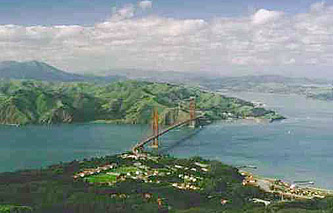
| |
The Presidio, seen at the bottom, is the 1,480-acre park on the edge of San Francisco leading to the Golden Gate
|
[Editor's note: It could be easily mistaken for a lovely travel brochure.
Bicyclists lazily pedal past a vintage cottage; exotic flowers bloom; quaint old brick buildings and wooden porches glow with warmth; open space and misty woods invite. "An incredible opportunity to participate in the preservation of a national jewel," the brochure touts.
The place described is the Presidio of San Francisco. And behind the rhetoric of "preservation," one thing is perfectly clear: Most of this park will soon belong to the highest acceptable bidder -- with the blessing of Congress and President Clinton. The big winner so far is filmmaker George Lucas, who was named "master tenant" -- the preferred developer of the mammoth Letterman/LAIR military hospital and research complex in the park.
But relatively few people have been paying attention to this unprecedented transformation. Blame the media in part; with the exception of San Francisco's alternative weekly, Bay Guardian, there has been little coverage of this complex story. But even diligent readers of that newspaper are forgiven if they don't have a good grasp of it all. Events moved fast and critical details were often obscured by decision-makers. Monitor investigative reporter Diana Scott spent almost a year attending public meetings and digging through piles of documents -- yet she still often found developments hard to follow. It was like trying to follow the hands of a carnival huckster that has mastered the shell game.
The impacts of this unprecedented deal won't be fully known for years, and may signal the end of the national park system as we know it. The land will now be publicly owned, yet privately occupied. And all these decisions are being made by the directors of the Presidio Trust -- men with privileged corporate connections -- who are operating behind closed doors and only loosely accountable to Congress.
To tell this important story, we have adopted a "hypertext" format used before in some of the most acclaimed Monitor features. Branching off from this main story are thirteen "sidebars" that explore a particular topic in depth. You can read just the article below and come away with a good understanding of the story, but you can also explore the alleyways leading away from there to learn more.
The saga of the Presidio is only one chapter in the story of the betrayal of our great National Parks. Our next installment will examine how the loggers and government officials conspired to plunder the Tongass rainforest on Alaska's coast. Together, they describe the most remarkable robberies of public property in our nation's history.]
| |
The National Park Service inherits a headache
 |
|
 |
Without
exaggeration, it is certainly the most desirable chunk of undeveloped urban real estate in the country. It is a city on the edge of the city of San Francisco, and one lost in time. Pass through at night as fog creeps in from the Golden Gate; in much of the Presidio, the mature forest of pine, cypress and fragrant eucalyptus shelter it from noise and glare of the modern world, and it is easy to imagine that it could be one hundred, two hundred years ago. It is a place without compare.
It is such a prize that many were astonished when the U.S. military announced in 1989 that it would surrender without a fight and decommission its historic showcase army base. By prior legislation, the Presidio would now become a national park. Exactly how that would happen was undetermined, but one thing was certain -- it wouldn't be cheap.
With the public land came a tremendous headache for the National Park Service (NPS): The cost of "upgrading" the unusually large number of vintage buildings. Clustered throughout the 1,480-acre park -- at places like the Main Post, Fort Scott, the massive Letterman/LAIR Complex, and Wherry Housing (the 2-4 bedroom units built for military families) -- are some 870 buildings. About five hunded are considered historically or architecturally significant; the remainder are earmarked for demolition. These structures represent an inventory of periods, styles, and functions (including Officers Club, golf club, swimming pool, bowling alley, post office, and Burger King). To bring them them up to code would cost about $660 million, the government estimated. For good reason, an administrator at another national park once called it "a $50 million a year maintenance sinkhole."
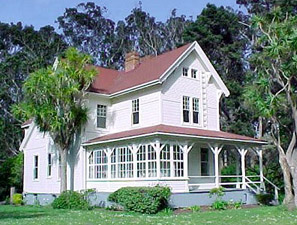
| |
Many buildings date back to the 19th century
|
The Park Service, with its budget threadbare and projects already backlogged, asked for federal help. It was the wrong time to go begging to Washington; Congress was entering the era of Gingrich. Bent on slashing public programs, Congress balked at the price tag and, after three years of wrangling, transferred management of 80 percent of the park (where most of the buildings are located) to a new quasi-public government corporation, disingenuously named the "Presidio Trust." Established in 1997, its charge is to rehab, lease, manage, demolish and develop over 6 million square feet of commercial and residential real estate -- and, by the way, to turn a profit by the year 2013.
| |
The Presidio Trust and the General Management Plan
 |
|
 |
Reaching
self-sufficiency by 2013 was paramount, thanks in part to a "poison pill" included by Congress: If this goal isn't met, the land will be sold at public auction. Could the Trust do it? Skeptics thought it was a set-up -- that it was meant to fail so that ownership of the land would eventually be privatized. But the newly-created Presidio Trust was given considerable leeway by Congress to bypass normal channels required of private development. This would shave 7-15 years off their timeline, Congress was told by the Trust's chairman.
When the smoke cleared, the Presidio Trust was given considerable financing powers, including:
- $50 million credit line from the U.S. Treasury
- Power to insure up to 75 percent of private loans for its projects (to leverage private borrowing)
- Power to select both commercial and residential tenants without public review (or Park Service approval)
- "Streamlined" development and leasing authority
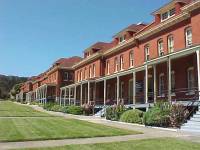
| |
The old infantry barracks are currently used as offices
|
Trust members also made a critical decision to rent only at San Francisco "market rates" -- whch were at all-time highs because of a booming economy and space crunch in the city. There was another lure for any corporation that could pay those high rents: Leases could for as long as 99 years (although most would be less than half as long). And still another plum in the agreement ensured that leases can't be broken even if the park is sold.
For all practical purposes, a century-long lease was as good as privatization, the chairman of the Trust told Congress, and is particularly valuable if the tenant can't be evicted by a new owner. Thus anyone with a lease can comfortably settle in as if they owned the place -- because they essentially did.
Not that Congress gave the Trust carte blanche; There was a "salvage" amendment added the next year to include a General Management Plan (GMP) for the Presidio. The plan -- worked out in many meetings with institutional and public input over previous years -- called for "a global center dedicated to addressing the world's most critical environmental, social, and cultural challenges."
That vision reflects early post-cold war optimism, particularly the heady sense that a new environmental paradigm for development was in the air as the Berlin Wall came down, the Soviet Union dissolved, and Gorbachev set up his short-lived institute for world peace in the park. Specific uses considered by the Plan to be compatible with the national park setting included education, arts, scientific research, environmental studies, scientific inquiry, healthcare, philanthropy, conflict resolution, and international relations.
But Congress failed to establish a formal mechanism for implementing the GMP amendment throughout the 80 percent of the park controlled by the Trust. The corporation isn't answerable to the National Park Service, which authored the GMP, nor its parent agency, the Department of Interior. The Presidio Trust -- with its Board of Directors weighted with real estate interests -- would soon scuttle parts of the GMP not to their tastes.
| |
Creating the appearance of public support
 |
|
 |
With
these rules set, the Trust began sending out a "Request for Qualifications" (RFQ) for developers in August, 1998. (The RFQ was the first step in a two-phase process in which qualified applicants were shortlisted and invited to submit full-blown proposals.) "The Presidio Trust will give priority to respondents that enhance the financial viability of the Presidio," said the guidelines.
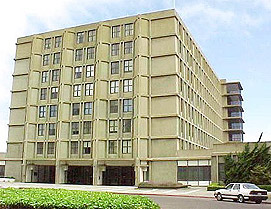
| |
Modern buildings in the Letterman complex are slated to be demolished, including this 550 bed hospital
|
Beyond income generation, criteria for selection were fuzzy. The Trust unilaterally expanded "mission compliant" uses described in the Plan to include computer and biotech industries -- although the latter was specifically frowned upon by the GMP.
But the Trust's RFQ stated, "Based on current market conditions, prospective tenants might also include those involved in...biotechnology, multimedia, computer graphics, telecommunications, film production, Internet-based research and development, computer software, environmental science, and other high-technology, knowledge-based industries" -- in retrospect, the Trust's guidelines for the Letterman complex seemed written with George Lucas in mind.
Reading the complex RFQ for the Letterman/LAIR complex, Joel Ventresca, founder of Preserve the Presidio Campaign, found the Trust was misleading the public; it was industrial tenants that the Trust sought. "These four areas [telecommunications, multimedia, biotech and health sciences] are industries incongruent with a national park setting," Ventresca says. "Can you imagine inviting those industries into Golden Gate Park? National parks are supposed to be -- and have been since 1960 -- outside of market forces, with guaranteed public subsidy. They are corrupting one of the most important things that's ever happened in the United States, one of the first countries to create a public park system....You're destroying the very thing you're trying to save."
But members of the public trying to participate in the process quickly found that reaching consensus isn't part of the way the Trust does business. Public workshops were held to solicit input on a range of predetermined questions. During this process, strong opposition to the idea of high-tech industry as an appropriate park development priority was voiced, but not recorded as such. An October Trust summary of public input on uses for Letterman/LAIR buried the lack of consensus in a footnote, which stated that its recommendations did not necessarily indicate a consensus. Yet, sub-group brainstorming sessions within public workshops were used to create the appearance of public support for Trust decisions as it drifted farther away from the General Management Plan.
| |
Trust supporters became disillusioned
 |
|
 |
Expanded
uses, fast track development, and secrecy fueled speculation about an inside track. "They know who the tenant is, or they never would have filed [the Financial Management Plan] with Congress," said Justin Cohen, vice president of the Coalition of San Francisco Neighborhoods, and a director of Pacific Heights Residents Association, as bidding began. He continued lobbying for the "transparency" that Congress intended when it required the Trust hold two public meetings a year, and for the release of tenant reports on which the leasing strategy is based. "The devil's in the details," he says concerning withheld information.
Cohen's group is one of the few vocal critics of the Presidio deal. San Franciso Democrats long ago closed ranks behind Congresswomen Pelosi, Boxer, and Feinstein who leveraged the original deal to "save" the Presidio, leaving volunteer groups like those headed by Cohen and Ventresca as the only watchdogs.
Advocacy for the GMP goals now falls to the Presidio Alliance, a voluntary membership organization of Presidio park tenants and other "stakeholders" whose common objective to make sure "green" is not forgotten.
Viveka [her Buddhist name] of the Urban Habitat program, which occupies the old Red Cross building at the Presidio, thinks that the lack of public information was "a great reason to be nervous, but people have to be pro-active, to push for something to happen." But she recalled the months before the selection of Lucas as developer "a confusing period," with socially-conscious tenants attempting to engage in a "reasonable conversation" with their new landlord.
Gradually the environmental supporters and tenants of the park became disillusioned. Their"wait-and-see" attitude had given the Presidio Trust a honeymoon period, until the impact of the undeniable commercial development of the Presidio that was to come became apparent.
| |
Destruction of public housing
 |
|
 |
Typical
of the disappointments was the gamesmanship played with the non-profit California Indian Museum -- the kind of cultural resource well-suited to the park's mission as articulated in the General Management Plan. The museum has been repeatedly frustrated in its years-long negotiations to secure a Presidio lease: first by the Park Service, and later by the Trust. It has sought space outside the park for its museum, even as the Trust continues to issue RFQ's for other buildings.
But the major issue for most advocate groups is the destruction of public housing. An early confrontation with homeowners in surrounding upscale neighborhoods was avoided by renting comparable low- end Wherry housing to students, rather than to homeless people. The Trust has also deflected some criticism from veterans groups by agreeing to accommodate 100 veterans involved in a job training program run by the Swords to Plowshares group. (According to former housing chief Ted Dienstfrey, this was a deal made before the Trust existed.)
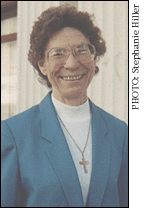
| |
Sister Bernie Galvin
|
Presidio Trust Executive Director James Meadows says rental income will ultimately pay for demolition and plans to phase out one-third of the existing 466 units at 10-year intervals, banking space for new housing elsewhere in the park. But Meadows hadn't figured on Sister Bernie.
Sister Bernie Galvin of the Religious Witness with Homeless People started the interfaith coalition to help the homeless in 1993, when the city police had been mandated to remove them from doorways and parks under then-Mayor Jordan's "Matrix" policy. She has championed the fight to preserve Wherry Housing in the Presidio. The result of her work was the landslide passage of Proposition L in June, 1998, whose intended purpose was to salvage Wherry for the city's poor and homeless. (Paradoxically, under the McKinney Act, preservation of housing on other military bases converted to civilian use for subsequent use by the homeless has become a government priority.) Meadows maintains that the Trust isn't bound to honor Proposition L.
Rental housing will be available both for long-term and short-term tenants; short-term interim leases are being negotiated with students, faculty and federal employees. (The Trust has said it will subsidize low-end employees at 40 percent of their income, but hasn't committed to how many.) Long-term leasing plan is available only for employees of firms with offices in the Presidio, and it comes with a company-town catch -- lose your job or quit and your lease is gone.
While some envision the future Presidio, with its toney ambiance and own police force, as a variation on a gated community, San Francisco realtor Carren Shagley compared it to a 19th century company town. There, labor was cheap because housing was provided, but job loss was catastrophic, catapulting laid-off employees into homelessness. "Here, discrimination is based on income, which isn't covered by HUD [regulations]," she says.
"The Presidio will be a great place if [Trust board members] get their way: well cared for, pretty houses, a gorgeous setting. We can picnic there. Like going back to the '50s when everything was hunky dory. But wait a second: we're still not addressing any of our problems."
| |
Which model of "sustainability?"
 |
|
 |
James
Meadows, executive director of the Presidio Trust, is the master of painting the pretty picture. In response to questions at public meetings about affordability of and broad access to housing, he loosely paraphrased the website from his previous project: "There'll be all kinds of people, because there'll be all kinds of homes, from entry level, to single family, to custom lots...luxury apartments....Because it's diversity, after all, that makes a community great."
Converting a former military base into a corporate town in which all housing and amenities will be ultimately for employees -- even one where employees walk "sustainably" to work and where government parkland is leased rather than sold outright -- doesn't quite live up to its rosy "model sustainable 21st century park" billing. In fact, it looks a lot more like the corporate past with a happy face.
Meadows laurels rest on transforming Denver's decomissioned Lowry Air Force Base into civilian housing; Meadows' expertise is real estate development. He lives in the park, routinely touts the environmental benefits of walking to work, and is paid $150,000 a year ($22,000 more than he earned at Lowry). His obvious qualification for the current job was a reputation for jump-starting development, because speed is critical to maximizing financial gain while the real estate market is "ripe." Any understanding he may have of the concept of "environmental sustainability" -- nurturing a balance between human and other natural ecosystems -- seems vague.
But overshadowed by the flurry of attention devoted to developing the Letterman/LAIR complex as a revenue generator is a critical question: Which model of "sustainability" will the park represent? Support for the expensive conversion of this former military base into a national park originally coalesced around the model of a global center -- a late-20th century, west coast version of the United Nations, dedicated to research and education related to solving pressing environmental problems and issues critical to maintaining peace. Yet, the vision of a "world class" center for international and environmental problem-solving has been eclipsed by the Trust's raison-d'etre: to achieve "financial sustainability" or "self-sufficiency," a novel model for a federal park.
| |
A sweetheart deal for George Lucas
 |
|
 |
But
the name of the game isn't sustainability -- it's "show me the money."
The Presidio Trust had a sweetheart deal to offer chosen tenants: Any new construction would be free from obeying city housing laws, stringent local design controls and buildings restrictions, plus paying city and state taxes. The Presidio is exempt from city housing laws, design and building restrictions, and from city and state taxes. Yet its future is now linked to San Francisco's real estate market, the most expensive in the nation.
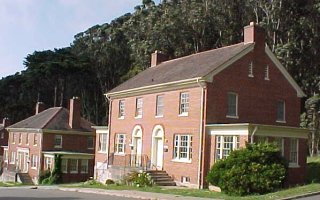
| |
|
Commercial development in the City of San Francisco -- perhaps the most scenic city in the country -- normally comes with a pricetag: new hotels or office projects (but not residential, institutional, or primarily retail ones) must meet certain planning criteria, including public amenities, and developers must pay fees to offset additional costs incurred by the City as a result of new demands on services. In the case of development on federal parkland in the Presidio of San Francisco, these fees do not apply because of federal jurisdiction, even though new development will impact the City. Instead, the Presidio Trust determines which fees it will collect above and beyond the rent.
Aside from payment of sewer fees by the Trust to the Public Utilities Commission (which don't actually compensate for additional stress on the environment from releasing more disinfected wastewater, even assuming the existing treatment system can process it), fees to mitigate the impact of commercial development in the park on other city services has not even been a subject of public discussion.
By building on rented federal parkland in the Presidio of San Francisco, Lucas -- and any other developer -- avoids the incredibly high cost of buying land in San Francisco, as well as paying at least $16 million in municipal fees to defray citywide impacts of new office development, not to mention city and state tax savings. Not bad for a semi-secluded San Francisco location with stunning views of the Bay, located close to a boutique shopping district and walking distance from such amenities as YMCA, swimming pool, tennis courts, residences, bowling alley, golf club, and lots of natural habitat.
Then there's money that the Trust gets directly. Under current law, the National Park Service and the Trust receive separate Congressional appropriations -- the NPS for some park-wide services (like educational and interpretive programs, and police) and for managing 20 percent of the park's most publicly used areas, such as the coastal beach, bluffs, and some interior forests -- and the Trust for administering the remaining 80 percent. In FY2000, the Trust's cut is $24 million -- more than four times the amount given to the NPS. The Trust's appropriation in addition to all of the rental fees the Trust raises from the leasing of park property, that go into its coffers.
The Trust will retain the revenues from parkland rentals, something the National Park Service is prohibited by law from doing to finance its operations, developing and managing 80 percent of the Presidio. The remaining 20 percent -- mainly coastal bluffs, open space, and forests -- is all that remains under NPS management. This division of oversight responsibility will remain in place after Congressional subsidies end in 2013, and whether, or to what extent the 80 percent of "parkland" will be open to public use is anybody's guess.
| |
It could have been molded into anything we could dream
 |
|
 |
The
Presidio was officially decommissioned by the U.S. Army in 1994, after 218 years as a military base under flags of three nations; Spain, Mexico and the United States. A city on the edge of a city -- separated as much by the invisible boundary of its federal status as by its history and geography -- could have been molded into anything the best minds of our Nation could dream.
Asked what scenario she'd like to see for the park, Diane Coward, Presidio Alliance co-founder and organizer of the Presidio Tenants Association, ticked off items with ease:
- An economically balanced mix of tenants, including low-budget nonprofits and small businesses committed to participation in a park community, and supportive of the sustainable goals of the General Management Plan
- A park-based water treatment facility
- Residential solar energy (following the example of panels installed on roofs of homes, for a fee, by Sacramento Municipal Utility District, for which there was enthusiastic demand)
- Recycling, reuse, and composting, in action and as educational programs
- On-site sewage treatment and power generation (solar, wind, co-generation)
- On-site permaculture (a system of farming which takes advantage of the angle of sunlight, flow of rain, beneficial insects and plant combinations to deter predators, ponding to produce biomass for soil enhancement, and even force-of-gravity method for rolling compost downhill) for local food production and as an educational tool
- Use of sustainable construction techniques and materials (exemplified at Thoreau Center, where 73 percent of demolition debris and salvaged materials were used to create healthy buildings), supported by Alliance guidelines and enforced by Trust oversight.
Coward's list goes on: historic preservation; a community engaged in development decisions; civic participation, including access by geographically remote lower income communities to the park for recreation and employment. "Who gets jobs is determined by the ability to afford Presidio housing, or the ability to drive," she notes. Then, pausing, she poses the all-important question: How would it affect sustainable development of the Presidio if no 15-year-limit on the experiment were imposed and self-reliance, rather than self-sufficiency, became the goal?
"Fifteen years [now 13] is an impossible goal. Failure isn't an option, because if [Trust executive director Jim] Meadows fails, it's gone," which short-ciruits the whole vision. This is an experiment with a huge price to pay if it fails, and that's not okay" says Coward.
For "The Presidio that Could Have Been" to become "The Presidio that Can Still Be," the total Congressional allocation over 15 years would be best spent more slowly and thoughfully. What better place to stand an outmoded rapid growth paradigm on its head -- to exchange commodification of public parkland for human resource-based environmental design -- than at the national park initially hailed as the embodiment of "swords into plowshares?" Greater use could be made of organized volunteer resources such as the Presidio Alliance, appropriate technology, broad-based fundraising, and sustained community input -- the latter not just for managing public opinion, but for actual decision-making.
| |
The failure of the Trust's model
 |
|
 |
By
definition, a corporation -- even a government corporation -- operates outside the usual public agency framework of accountability. In the long run, this is as costly to the federal treasury as to the environment.
And here is the dirty little secret of the whole scheme: the Pennsylvania Avenue Development Corporation (PADC) -- the government corporation on which the Presidio Trust was modeled -- was an utter failure, with some $800 million in cost-overruns and abandonment of all its well-meaning objectives.
The goal of PADC was transforming a blighted section of Washington D.C. into a model residential and retail community. While PADC attracted $600 million of private capital to the area, the record also shows unfathomable building construction cost-overruns, and far less success in meeting public interest goals, including the creation of mixed use development. The original plan for 1,500 housing units was slashed to 745, and those were luxury apartments in just four buildings. Efforts to promote business were reduced to acting as a land broker for private developers.
Nor did the public have much say in that project. Environmentalists and African Americans testified at Senate subcommittee hearings against the exclusion of citizens from decision-making, and the bankruptcy of urban renewal assumptions; PADC was even sued by a citizens group for its unresponsivenes to citizen pressure to preserve significant historic buildings.
All of this sounds uncomfortably like the situation with Presidio Trust, with the added concern that once the Presidio Trust signs long-term leases with commercial tenants, creating contractual obligations, there may be few legal avenues open.
Notwithstanding hoped-for adoption of "green building" and transportation standards at the Presidio, leasing practices look less like the future and more like the past. Not surprisingly, considering recent Congressional support for large-scale lumbering and mining concessions, they recall a time when private concessionaires viewed national parks as their private backyards.
Whispered in private and shouted in the local advocacy press, these questions still await discussion in mainstream public forums. With the planned infusion over 15 years of at least $300 million federal dollars (estimated by the Trust) into the Presidio, and hundreds of millions more through private financing, the Trust's closely-held leasing plans for public parkland are increasingly worrisome.
Critical to assessing the significance of this arrangement from sparse, slowly emerging details, is a two-pronged question: Will the Trust's financial maneuvers create "a global center dedicated to addressing the world's most critical environmental, social, and cultural challenges" as stated in the General Management Plan? Or, will it succeed merely in turning the park -- and perhaps the whole federal park system -- into a giant cash register?
Diana Scott is a San Francisco-based writer and architecture critic who specializes in environmental design, and has covered
community-based planning, urban history, and habitat reclamation for the Albion Monitor. She has written for San Francisco Bay
Guardian, Examiner, and the New York TimesPhotos courtesy National Park Service
Comments? Send a letter to the editor.Albion Monitor
December 28, 1999 (http://www.monitor.net/monitor)All Rights Reserved. Contact rights@monitor.net for permission to use in any format. |
|

